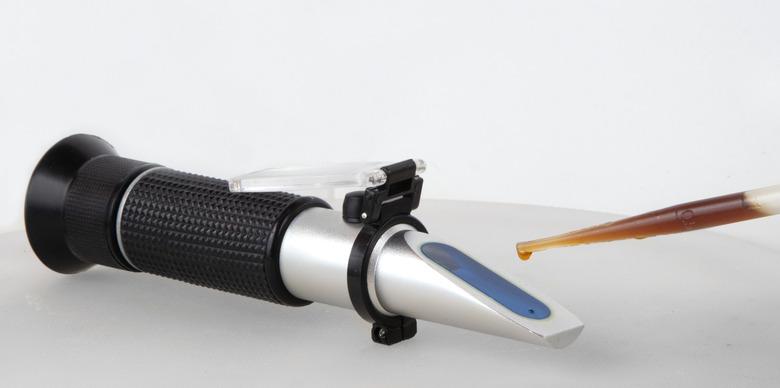How To Calibrate A Refractometer
A refractometer measures the "bending" of light as it passes through some material. This phenomenon is known as refraction, and its measurement is called a refractive index. The refractive index for a solution of a known substance can be used to calculate the concentration of that solution. For example, winemakers use a special type of refractometer to determine the amount of sugar in grape juice. A refractometer's reading can be affected by a variety of factors, and it must therefore be calibrated frequently.
Step 1
Select the calibration liquid. Some models use a special calibration liquid while others use distilled water. Lift the daylight plate and place 2 to 3 drops of the calibration liquid on the prism assembly.
Step 2
Close the daylight plate and allow the calibration liquid to spread across the prism without any dry spots. Wait 30 seconds so the sample can reach the temperature of the refractometer.
Step 3
Point the refractometer toward a natural light source since artificial lighting can cause the reading to be inaccurate. Look into the eyepiece and adjust it so that the scale is in focus. Adjust the calibration screw so that the refractometer reads exactly zero.
Step 4
Clean the daylight plate and the main prism assembly with a soft, damp cloth. Place 2 to 3 drops of the test solution and take a reading as before.
Step 5
Interpret the refractometer reading. This type of refractometer typically measures the concentration of the sugar in the grape juice on the Brix scale, which essentially measures the sugar concentration as a percentage. A reading of 25 therefore indicates a 25 percent solution, or 25 grams of sugar dissolved in 100 ml of water.
Things Needed
- Calibration liquid
- Refractometer
- Soft cloth
Cite This Article
MLA
Robinson, Allan. "How To Calibrate A Refractometer" sciencing.com, https://www.sciencing.com/calibrate-refractometer-5233419/. 28 July 2009.
APA
Robinson, Allan. (2009, July 28). How To Calibrate A Refractometer. sciencing.com. Retrieved from https://www.sciencing.com/calibrate-refractometer-5233419/
Chicago
Robinson, Allan. How To Calibrate A Refractometer last modified March 24, 2022. https://www.sciencing.com/calibrate-refractometer-5233419/
